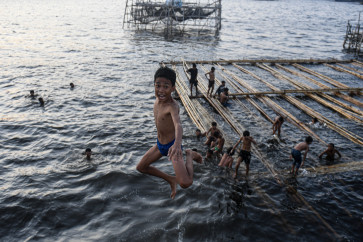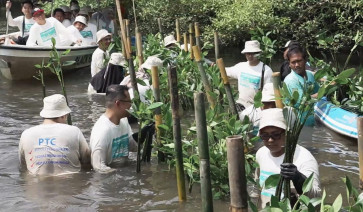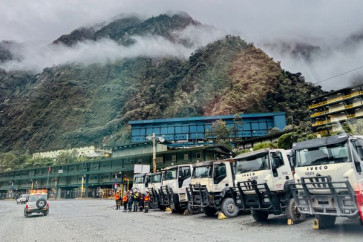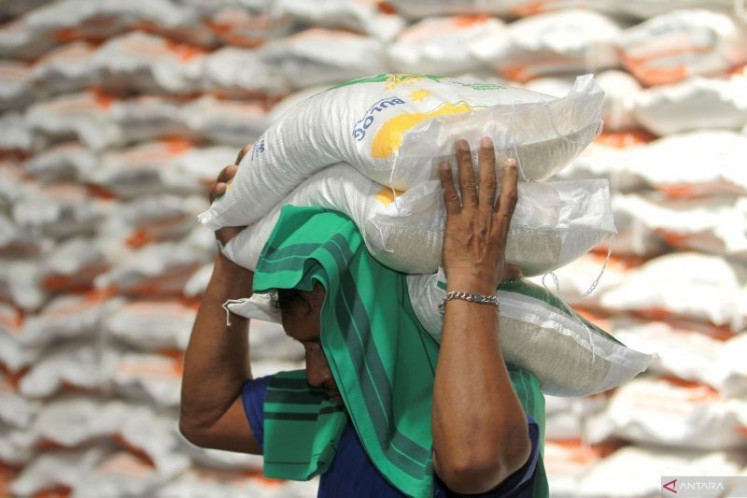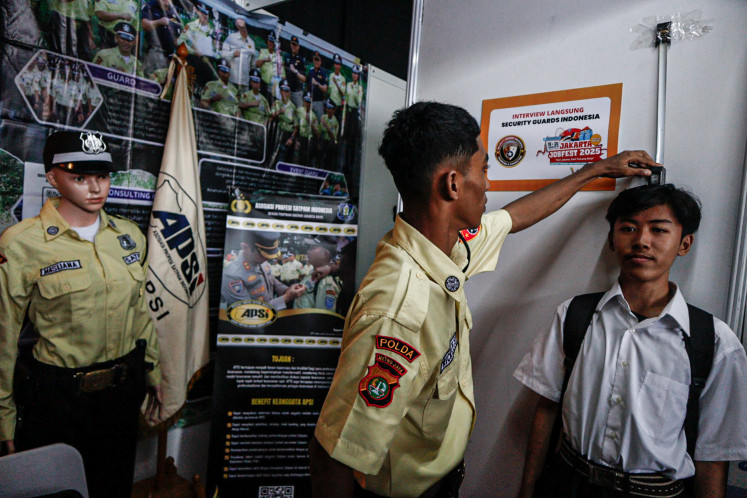Popular Reads
Top Results
Can't find what you're looking for?
View all search resultsPopular Reads
Top Results
Can't find what you're looking for?
View all search resultsASEAN should integrate despite disputes
When Indonesia took the chairmanship of ASEAN in January, it could not have asked for a more challenging task than to deal with the military clashes which have erupted between Thailand and Cambodia over a border dispute
Change text size
Gift Premium Articles
to Anyone
W
hen Indonesia took the chairmanship of ASEAN in January, it could not have asked for a more challenging task than to deal with the military clashes which have erupted between Thailand and Cambodia over a border dispute. Jakarta had some grand designs when it asked Brunei to swap places for the right to chair the regional grouping as Indonesia’s turn was not due until 2013.
But as ASEAN under Indonesia’s chairmanship forges ahead with the creation of a Southeast Asian Community by 2015, the clashes on the Thai-Cambodian border are a reminder of the many territorial disputes among its 10 members that for much of its 44-year history have been swept under the carpet.
Some border disputes are hard if not impossible to resolve, except through a war where one party wins and the other loses. The overlapping territorial claim by both Thailand and Cambodia over the border region that houses the historic Preah Vihear Temple is one such example.
To both sides, this is a matter of sovereignty. Neither country is prepared to give up an inch of land, and both sides are prepared to go to war if necessary. Many territorial disputes within ASEAN are the legacy of the European colonial rulers that carved the region according to their economic interests.
In the case of the Preah Vihear Temple, however, it goes back centuries and predates European colonialism, making a solution to the problem extremely contentious. While it may be unfair to judge Indonesia’s leadership of ASEAN in 2011 by how it manages the Thai-Cambodia conflict, given the near impossibility of finding a settlement that would satisfy both sides, it is still a blessing in disguise for the region that the clashes have happened under its watch. Indonesia as the most influential ASEAN member can use its weight and diplomatic resources to prevent the skirmishes from escalating.
ASEAN’s founding fathers got it right when they decided to put aside overlapping territorial claims and border disputes, and instead focused upon turning Southeast Asia from a zone filled with wars and conflicts that marred relations in the 1960s into a region of peace, development and cooperation. Looking back, without ASEAN, the region would not have developed and prospered the way it has.
Each ASEAN country has a border and/or territorial dispute with almost all its neighbors. Some of these are being resolved bilaterally through long negotiations. One or two of these territorial disputes were also brought before the International Court of Justice.
Unfortunately, the settlement reached at the Court did not inspire confidence for others to utilize the same adjudication process in other territorial disputes. Indonesia for one is unlikely to go back to The Hague any time soon after it bitterly lost Sipadan and Ligitan, two islands off the northeast of Borneo, to Malaysia in 2002.
The Court recognized that both countries had legitimate claims based on the map they inherited from their former colonial rulers, respectively Holland and Britain, but gave sovereignty to Kuala Lumpur simply because it had a de facto jurisdiction. The lesson for Indonesia was to ensure that all its remaining 17,504 islands -- it was officially 17,506 in 2002 -- particularly those furthest on the border are populated.
Meanwhile, Malaysia was not so fortunate when it returned to The Hague for a ruling over its territorial dispute with Singapore. The court in 2008 gave the more strategic Pedra Branca Island to Singapore and Middle Rocks to Malaysia. The court noted that the Sultanate of Johore, which held the original title over Pedra Branca, waived its claim in 1953 to Britain, Singapore’s administrator at the time, and that Singapore had since conducted activities on the island without any protest from Malaysia.
These elements were not present in Singapore’s claim of the adjacent Middle Rocks islands, and so the court granted possession to Malaysia. Indonesia would have been content with this type of a Solomon justice in 2002 and probably would not have lost confidence in turning to the International Court of Justice again.
While the ASEAN Charter, signed by leaders of all 10 member countries in 2007, provides for a regional conflict-resolution mechanism, it was not designed for settling territorial disputes among members. After the first salvos were fired between Cambodia and Thailand in January, neither country expressed interest in turning to the ASEAN Charter.
Thailand insisted on solving this conflict bilaterally without outside interference and Cambodia quickly turned to the UN Security Council, only to be told to let Indonesia mediate within the framework of ASEAN. More recently, Cambodia has taken the issue to the International Court of Justice in another show of no confidence in ASEAN. Given Bangkok and Phnom Penh’s distrust of ASEAN, Indonesia’s task as a mediator has been made that much harder, and expectations of what Indonesia can do should therefore be more realistic.
Sweeping the big and difficult issues under the carpet is not exclusive only to ASEAN. European countries are not entirely free from long and unresolved border and territorial conflicts -- the dispute over Gibraltar between Britain and Spain is but one example -- yet they have been able to forge the creation of the European Union and turn it into a borderless community.
One close ASEAN watcher has suggested that Indonesia should use its chairmanship to push for even speedier integration of the region and make the borderless Southeast Asia concept a reality. Once walls are lifted, the argument goes, it matters little who controls the border territories.
These intra-ASEAN disputes would seem miniscule compared to the looming battle most members now face with China, which lately is flexing its muscle in exercising its territorial and maritime claims to the South China Sea. China, which has many overlapping claims in this region with some ASEAN countries, is insisting that these disputes be resolved bilaterally, rather than multilaterally.
The Thai-Cambodian border conflict may be taking much of the time and energy of Indonesia’s
Foreign Minister Marty Natalegawa, who has shuttled between the two capitals, but it should not stop Indonesia from pushing forward with whatever grand designs it had in mind for ASEAN, including setting a new agenda for the group beyond 2015.
The territorial conflict and others like it are speed bumps that may provide discomfort for ASEAN on its way to becoming a community in 2015, but they should not in any way become an obstacle to stop the integration process. The real test for Indonesia’s chairmanship is not whether it can resolve the Thai-Cambodian border dispute, but whether it can get everyone to stay on the course of ASEAN community, in spite of it.
The writer is Visiting Fellow at the East-West Center in Washington and formerly editor-in-chief of
The Jakarta Post.


